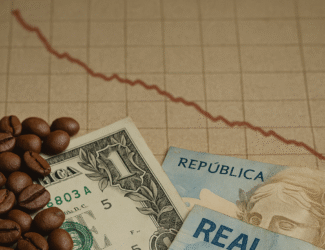
Arabica Coffee Prices Decline Amid Accelerated Harvest in Brazil
In recent trading, September Arabica coffee (KCU24) saw a significant decline, closing down by -4.45 cents or -1.90% on Friday, while September ICE Robusta coffee (RMU24) also fell sharply, closing down by -93 dollars or -2.12%. This movement in coffee prices comes as the harvest pressures in Brazil, the world’s largest producer of Arabica coffee beans, continue to mount.
Harvest Progress and Its Impact
Brazil’s 2024/25 coffee harvest has been progressing at a rapid pace, with 81% of the harvest completed as of July 23. This is notably faster than the 74% completion rate at the same time last year and the five-year average of 77%. Specifically, the Arabica coffee harvest is 75% complete, surpassing last year’s 65% and the five-year average of 69%. The Robusta coffee harvest is even more advanced, with 95% completion compared to 89% last year and a five-year average of 93% (Barchart.com) (Barchart.com).
Weather Conditions and Their Effects
The weather in Brazil has played a crucial role in shaping the current market scenario. Somar Meteorologia reported that the Minas Gerais region, responsible for about 30% of Brazil’s Arabica crop, received no rain last week, against the historical average of 2.6 mm for this period. This lack of rainfall is generally supportive of Arabica coffee prices as it may affect the yield and quality of the coffee beans (Barchart.com) (Barchart.com).
Inventory Levels and Market Reactions
An increase in ICE coffee inventories has also influenced market dynamics. Robusta coffee inventories monitored by ICE rose to a one-year high of 6,521 lots on Thursday, up from a record low of 1,958 lots in February 2024. Similarly, Arabica coffee inventories saw a rise to a 1.5-year high of 842,434 bags on June 25, up from the 24-year low of 224,066 bags recorded in November 2023. By Thursday, Arabica inventories were slightly lower at 814,801 bags (Barchart.com) (Barchart.com).
Global Production and Export Dynamics
Global production forecasts and export data have added further complexity to the market. The USDA’s Foreign Agriculture Service (FAS) projected a 4.2% year-on-year increase in world coffee production for 2024/25, reaching 176.235 million bags. This includes a 4.4% increase in Arabica production to 99.855 million bags and a 3.9% increase in Robusta production to 76.38 million bags. The FAS also forecasts that ending stocks will climb by 7.7% to 25.78 million bags from 23.93 million bags in 2023/24 (Barchart.com).
Vietnam, the largest producer of Robusta coffee, is experiencing challenges that are influencing global prices. The agriculture department in Vietnam projected a 20% drop in coffee production for the 2023/24 crop year, primarily due to drought conditions. This has led to the smallest crop in four years, estimated at 1.472 million metric tons. Consequently, the Vietnam Coffee Association anticipates a 20% year-on-year drop in coffee exports to 1.336 million metric tons. This decline in exports is bullish for coffee prices as it suggests reduced availability in the global market (Barchart.com) (Barchart.com).
In addition to these factors, the International Coffee Organization (ICO) reported a 5.8% year-on-year increase in global coffee production for 2023/24, amounting to 178 million bags, due to an exceptional off-biennial crop year. Despite this, global consumption rose by 2.2% to 177 million bags, resulting in a surplus of 1 million bags (Barchart.com) (Barchart.com).
Market Outlook and Conclusion
The coffee market is currently facing a mix of bullish and bearish factors. While the rapid harvest progress in Brazil and increased global production forecasts apply downward pressure on prices, weather-related concerns in Brazil and inventory levels offer some support. The situation in Vietnam adds another layer of complexity, with potential reductions in Robusta coffee production and exports influencing future market dynamics. As these factors continue to unfold, market participants will closely monitor developments to gauge their impact on coffee prices moving forward (Barchart.com) (Barchart.com) (Barchart.com).



